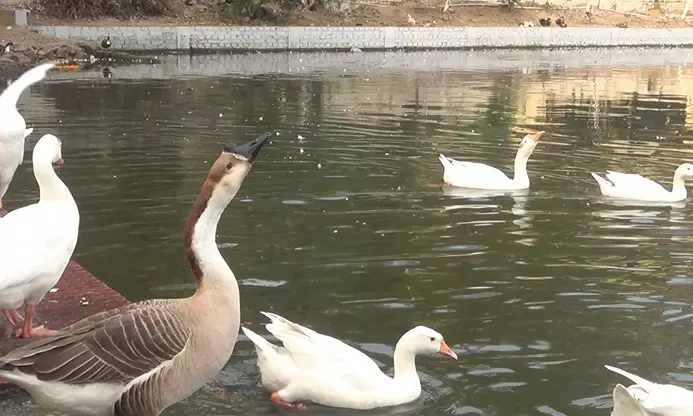
AT Photo
Guwahati, June 5: Being an avid observer of anything related to wildlife and environment, renowned Herpetologist Jayaditya Purkayastha did not miss sighting a small passerine bird known as magpie-robin that frequent his area of residence. On closely monitoring the bird he realised that the feathered friend comes every day at around 3 pm to quench its thirst from a dripping water tap that is operated at that particular time. “The bird would not have to wait to satisfy its thirst if it were a rural area as open water sources are found abundantly and every other household has a pond at the front yard,” said Purkayastha.
Ponds, locally known as “Pukhuris”, once dotted the landscape of the fertile land of Assam. However, with rapid urbanisation the water bodies are shrinking and posing a serious threat to the ecosystem. This ultimately results in artificial floods that have been leaving a disastrous impact in the urban landscape.
Why ponds are important?
Ponds can be home to several species from the unusual inhabitants to the unexpected ones. Both flora and fauna thrive around ponds which in itself is an ecosystem. It has the potential to reduce the risk of flooding and erosion damage from excess storm water runoff. Moreover, it also acts as a carbon sink in your backyard.
“The system of pond acts as a carbon sink, the carbon dioxide that accumulates in pond is released in the water and thereby removes carbon dioxide from the atmosphere. Interestingly, there are different types of algae found in ponds, so, 25% of oxygen in earth is provided by algae,” informed Purkayastha.
What’s the state of ponds today?
Purkayastha while lamenting over the shrinking of ponds in the urban space said that the importance of ponds was imbibed into us through our culture. Earlier, there used to be ponds in temples and namghars. The water required for pujas and other rituals were done from the water of the pond. So, historically there was a religious connection with the ponds, but we did not understand the message. “Perhaps now is the appropriate time to look back in history to learn how our ancestors always prioritised water planning while building the city. Moreover, the benefit of a pond will be received only when it is being treated as one, if we make it a swimming pool by renovating it, then it won’t be a pond anymore. The ecological and sociological benefit won’t be there,” added Purkayastha.
Anthropogenic causes including degradation of hills, elevated areas, choking off traditional water bodies and a messed up waste management system have all contributed to the shrinking of water bodies in the region.
“The situation has only aggravated over the years, when it comes to ground water recharge-- in urban landscape, there is water within the house when it rains but there is no drinking water in water taps and wells. This does not happen in villages except in some extreme situations, because in villages there are ponds in front of every other household and villages also don’t have the problem of water scarcity. But in urban areas since everything is concrete, so there is no chance of the groundwater getting recharged after the rains.
Strategies need to be implemented
Water bodies support a self-sustaining environment and host incredibly rich flora and fauna. These water bodies can be used wisely to supply limitless resources for the maintenance of dependent creatures. However, the majority of the water bodies have been completely destroyed by environmental deterioration. It is now essential to preserve the remaining water bodies. The Guwahati city has several water bodies distributed centrally and at the outskirt. The important water bodies include Jurpukhuri, Silpukhuri, Dighalipukhuri and Nagkotapukhuri. The Sola beel (lake) in the heart of the city and the Deeepor Beel in the western outskirt of the city on the other hand received highly polluted waste from surrounding areas and through a network of drains.
“Dighalipukhuri is the largest pond amongst others in Guwahati but then it is not biodiversity rich, these ponds are clean from above. The ponds within the city are mostly for recreational purpose. However, the patchy wetlands like the Deepor Beel or Sola Beel need to be conserved from human interference. The wetland will take its own course as the rejuvenation work is done by themselves. Nature can take its own care, only interference needs to be curbed,” said Purkayastha.
Purkayashta further warned that if the water bodies becomes extinct or reduces by size then there will more floods in the city. He further suggested that people can take initiative and built small water tanks if possible. Government can nominate places like educational institutes and organisations where ponds can be built to maintain the biodiversity.
“We need small ponds because they are by themselves an ecosystem. We need to reinstall the concept of urban ponds. Pond does not need huge space, it can be build up even in small space—it can be water shed or water holding area. Apart from managing the ecosystem it will also tackle the problem of water crisis for the people. Micro climate is changing drastically and traditional knowledge is not something which can be neglected. Science and traditional knowledge needs to go hand in hand. We have to look ahead with technology and sometimes we have to also look backward,” said Purkayastha.
